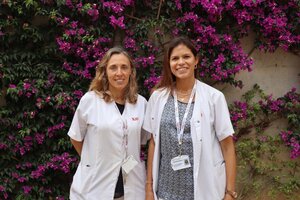New tool to predict severity in Nonketotic Hyperglycinemia, a rare disease
An international team led by Dr Àngels García Cazorla, a researcher at the Institut de Recerca Sant Joan de Déu and a pediatric neurologist at the SJD Barcelona Children's Hospital, has presented a new approach to nonketotic hyperglycinemia that can predict the severity in affected children. The study was published in the journal Annals of Neurology.
Nonketotic hyperglycinemia (NKH) is an inherited neurometabolic disorder with a variable clinical course and severities, ranging from infantile epileptic encephalopathy to psychiatric disorders. Currently, there are no biomarkers that can predict the disease course or strategies directed at each patient.
NKH is a minority disease (rare) that affects 1 in 76,000 children and affects glycine metabolism, specifically the protein cleavage system, mainly in the brain, liver and placenta. These problems cause the accumulation of large quantities of glycine in all body tissues, including the brain.
GLYCINE'S ROLE IN THE NERVOUS SYSTEM
Glycine is a non-essential amino acid, synthesized by the body, is involved in many metabolic pathways, and acts as a neurotransmitter. Glycine acts as a coagonist, together with glutamate, of NMDA receptors located on the neuron's postsynaptic membrane in the brainstem and spinal cord.
NMDA receptors have an essential role in neuronal plasticity, learning processes, and memory. And at the same time, its deregulation is implicated in certain neurological disease development, such as epilepsy, Parkinson's, Alzheimer's or schizophrenia. In children with NKH, the high concentration of glycine causes receptors' overactivation, as a consequence, they may present neonatal apnea, hypotonia, seizures, brain damage, etc.
Children with NKH can present the disease in two forms: severe (accounting for approximately 85% of patients) or attenuated.
In the first case, patients present with hypotonia, increasing lethargy, coma, apnea, myoclonic jerks, and severe epileptic seizures neonatally or in early infancy. Patients with attenuated NKH, in contrast, may have absent or easily controlled epilepsy together with hyperactivity, chorea, and attention-deficit/hyperactivity disorder (ADHD) and show variable developmental progress.
MAKING AN EARLY DETECTION CAN HELP TO A BETTER THERAPEUTIC APPROACH
Nonketotic hyperglycinemia is a rare disorder for which there is still no curative treatment.
"Currently, the treatment for patients consists of glycine concentration reduction through drugs and/or diet, use of NMDA receptor antagonists and treatment of symptoms. However, response to therapy is often disappointing, for this reason, it is crucial to know what the disease's evolution will be in the child to carry out an earlier treatment." Comments Dr Àngels Garcia Cazorla, Paediatric Neurometabolic Disorders: Neural Communication Mechanisms and Personalised Therapies of the IRSJD.
An international scientific study, with centers in Spain, Germany, Greece, Canada, the Czech Republic, the United States and France, has analyzed a cohort with 25 NKH patients by intending to make a much more precise categorization of symptoms and be able to perform a better clinical approach.
The study confirms that the NKH's different forms can be biochemically and clinically distinguished, although there is a small area in which the results are very similar to each other. In addition, five parameters can predict the severity: age at onset, CSF glycine, CSF/plasmaglycine ratio, presence of corpus callosum abnormalities and the genetic variants present in children.
"Our study expands our knowledge of the phenotypic spectrum of attenuated NKH and the number of pathogenic variants that cause the disease. Thanks to the study, we have been able to create a predictive model of the disease's severity based on clinical, biochemical and genetic parameters.", comments Dr Àngels Gracia-Cazorla. "We believe our results will help medical professionals improve to identify disease's attenuated forms and apply computational prediction of the variants' severity. These tools will improve clinical management and decision-making strategies, with clinical and biochemical predictors.
The results obtained by the Sant Joan de Déu research team may have a direct impact on clinical practice and the nonketotic hyperglycinemia management, since being able to predict the disease severity will help to apply a better earlier and better therapeutic strategy and improve the children's life quality.
The study is the result of an international collaboration between research and medical teams from Institut de Recerca Sant Joan de Déu, SJD Barcelona Children's Hospital, Universitat de Vic, Hospital Germans Trias i Pujol, Hospital Virgen de la Arrixaca, Hospital Universitario Miguel Servet, CIBERER, Children's Hospital Heidelberg (Germany), Children's Hospital in Hamburg (Germany), First Department of Pediatrics Aristotle University (Greece), Children's Hospital in Vancouver (Canada), General University Hospital in Prague (Czech Republic) and University Hospital in Nantes (France).
Reference paper
Kuseyri Hübschmann O, Palacios NAJ, Olivella M, Guder P, Zafeiriou DI, Horvath G, Kulhánek J, Pearson TS, Kuster A, Cortès-Saladelafont E, Ibáñez S, García-Jiménez MC, Honzík T, Santer R, Jeltsch K, Garbade SF, Hoffmann GF, Opladen T, García-Cazorla Á. An integrative approach to predict severity in nonketotic hyperglycinemia. Ann Neurol. 2022 May 26. doi: 10.1002/ana.26423. Epub ahead of print. PMID: 35616651.

We believe our results will help medical professionals improve to identify disease's attenuated forms and apply computational prediction of the variants' severity.
